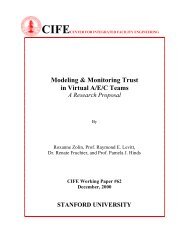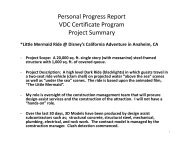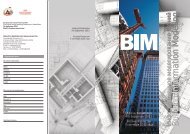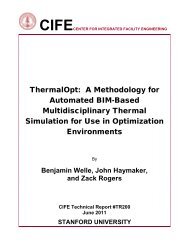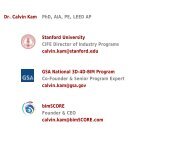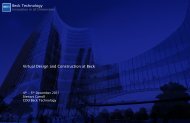Framework for Measuring Rationale Clarity of AEC Design Decisions
Framework for Measuring Rationale Clarity of AEC Design Decisions
Framework for Measuring Rationale Clarity of AEC Design Decisions
Create successful ePaper yourself
Turn your PDF publications into a flip-book with our unique Google optimized e-Paper software.
<strong>Framework</strong> <strong>for</strong> <strong>Measuring</strong> Rational <strong>Clarity</strong><br />
Page 9 <strong>of</strong> 22<br />
The definition <strong>of</strong> each component (except Managers) is directly dependent on at least the<br />
definition <strong>of</strong> one other component as shown by the connections. RCF measures the clarity <strong>of</strong><br />
each component <strong>of</strong> rationale with respect to seven conditions, illustrated in Figure 3.<br />
Figure 3: Conditions <strong>of</strong> <strong>Rationale</strong> <strong>Clarity</strong> - Definitions and Dependencies<br />
<strong>Rationale</strong> Components<br />
Howard (Howard 1988; 2007; Howard and Matheson 1983) provides a set <strong>of</strong> criteria <strong>for</strong> judging<br />
decision quality to guide attention toward weaknesses in the application <strong>of</strong> DA. This section<br />
builds upon Howard’s work by providing definitions and conditions <strong>of</strong> clarity <strong>for</strong> each DDR<br />
component.<br />
Moran and Carroll (1996) ask “Who will create the rationale?” Organization is central to the<br />
<strong>for</strong>mation <strong>of</strong> DDR. Contemporary design integration in the Architecture, Engineering, and<br />
Construction (<strong>AEC</strong>) industry is socially complex. Participants (e.g., planners, architects,<br />
engineers, and contractors) design, construct, and operate the buildings and infrastructure that<br />
help sustain human life and society. The organization <strong>of</strong> these projects influences views <strong>of</strong> their<br />
decision-making. Descriptively, “organizations will have structure… ins<strong>of</strong>ar as there are<br />
boundaries <strong>of</strong> rationality (March and Simon 1958).” Normatively, “An organization using<br />
Decision Analysis (DA) agrees to act as if it were a single entity using the logic <strong>of</strong> a person.<br />
Separate groups might have the assignment <strong>of</strong> creating the frame and the elements <strong>of</strong> the<br />
decision basis (Howard 2007).” The general rational framework (March 1994) views decision<br />
making in terms <strong>of</strong> both organization and decision components and this view provides a structure<br />
©2010 John Chachere & John Haymaker




